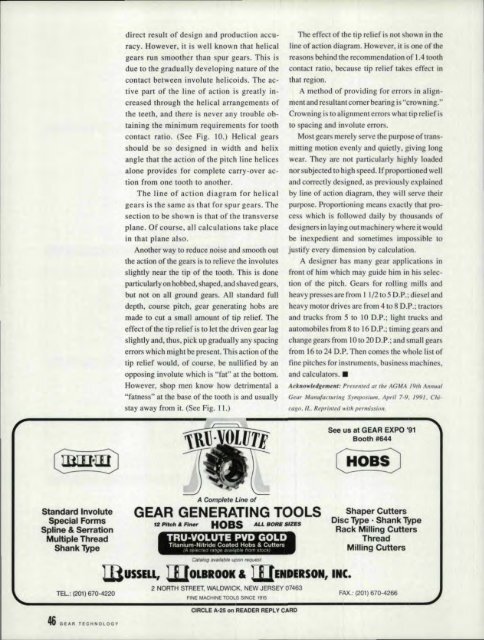Download the September/October 1991 Issue in PDF format - Gear ...
Download the September/October 1991 Issue in PDF format - Gear ...
Download the September/October 1991 Issue in PDF format - Gear ...
You also want an ePaper? Increase the reach of your titles
YUMPU automatically turns print PDFs into web optimized ePapers that Google loves.
direct result of design and prnduction accuracy.<br />
However. it is wen known that helical<br />
gears run smoo<strong>the</strong>rthan spur gears ...This is<br />
due to <strong>the</strong> gradually develop<strong>in</strong>g nature of <strong>the</strong><br />
contact between <strong>in</strong>volute heliccids, The active<br />
part of <strong>the</strong> l<strong>in</strong>e of action is greatly <strong>in</strong>creased<br />
through <strong>the</strong> helical arrangements of<br />
<strong>the</strong>teeth, and <strong>the</strong>re i never any trouble obta<strong>in</strong><strong>in</strong>g<br />
<strong>the</strong> m<strong>in</strong>imum requirements tor tooth<br />
contact ratio. (See Fig. 10.) Helical gears<br />
should be so designed <strong>in</strong> width and helix<br />
angle<br />
that <strong>the</strong>action of <strong>the</strong> pitch l<strong>in</strong>e helices<br />
alone provides for complete carry-over action<br />
from one tooth to ano<strong>the</strong>r.<br />
The Hoe of action diagram for helical<br />
gears is <strong>the</strong> same as that for spur gears. The<br />
section to be shown is that of <strong>the</strong> transverse<br />
plane, Of course. all calculations take place<br />
<strong>in</strong> that plane<br />
also.<br />
Ano<strong>the</strong>r way to reduce noise and smooth out<br />
<strong>the</strong> action of <strong>the</strong> gears is t)O relieve <strong>the</strong> <strong>in</strong>volutes<br />
slightly neal <strong>the</strong> tip of <strong>the</strong> 'tOon'!.. This is done<br />
particularly onhobbed,<br />
shaped. and shaved gears,<br />
but not on all ground gears. All standard fun<br />
depth, course pitch, gear generat<strong>in</strong>g hobs are<br />
made to cut a small amount of tip relief. The<br />
effect of <strong>the</strong> tip relief is to let <strong>the</strong> driven gear lag<br />
slightly and, thus, pick up gradually any spac<strong>in</strong>g<br />
errors which might be present. This action efUIe<br />
tip relief would, of course. be nullified by an<br />
oppos<strong>in</strong>g <strong>in</strong>volute which is "fat" at <strong>the</strong> bottom.<br />
However, shop men know how detrimental a<br />
"fatness"<br />
at <strong>the</strong> base of 'Ihe tooth is and usually<br />
stay aw.ay from it (See Fig. II.)<br />
Tile 'effect of me tip relief is 1'101 shown <strong>in</strong> <strong>the</strong><br />
l<strong>in</strong>e nfaction diagram, However, it is one of <strong>the</strong><br />
reasons beh<strong>in</strong>d <strong>the</strong> recommendation<br />
of 1.4 tooth<br />
contact ratio, because tip relief takes effect <strong>in</strong><br />
that region.<br />
A method of provid<strong>in</strong>g for errors <strong>in</strong> alignme<br />
III and resu Ilant comer bea1<strong>in</strong>g is "crow n<strong>in</strong>g. "<br />
Crown<strong>in</strong>g i.to alignment errors what 'lip reliefis<br />
to spac<strong>in</strong>g and <strong>in</strong>volute error ..<br />
Most gears merely serve <strong>the</strong> purpo e of transmitt<strong>in</strong>g<br />
motion evenly and quietly. giv<strong>in</strong>g long<br />
wear. They are not particularly highly loaded<br />
nor subjected to high speed. If proportioned well<br />
and correctly designed. as previously expla<strong>in</strong>ed<br />
by Hne of action diagram.<br />
purpose. Proportion<strong>in</strong>g<br />
<strong>the</strong>y witll serve <strong>the</strong>ir<br />
means exactly that proee<br />
s which is followed daily by thousands of<br />
designer <strong>in</strong>lay<strong>in</strong>g out mach<strong>in</strong>ery where it would<br />
be <strong>in</strong>expedient and sometimes impossible to<br />
[u tify every dimension by calculation.<br />
A designer has many gear applications <strong>in</strong><br />
frnnt of him which may guide him <strong>in</strong> hi<br />
eleclion<br />
of <strong>the</strong> pitch. <strong>Gear</strong> for roll<strong>in</strong>g mills and<br />
heavy presses arefrom I 1/2 to 5 D.P.; diesel and<br />
heavy motor drives are from 4 'W 8 D.P.; tractors<br />
and trucks from 5 to IO D.P ..: light trucks and<br />
automobiles<br />
from 8 to l6 D.P.; tim<strong>in</strong>g gears and<br />
change gears from 10 to 20 D..P..; and small gears<br />
from 1.6to 24 D.P. Then comes <strong>the</strong> whole list of<br />
f<strong>in</strong>e pitches for <strong>in</strong>struments,<br />
and calculator<br />
.•<br />
bus<strong>in</strong>ess mach<strong>in</strong>es,<br />
AcknoH1ledg.ement: Presented at <strong>the</strong> A.GMA 19(11 A'JIlua{<br />
<strong>Gear</strong> ManufaC1ur<strong>in</strong>g Symposium. April 7-9. <strong>1991</strong>. Chicago.H:<br />
Repr<strong>in</strong>ted ....itli permission.<br />
See us' at GEAR EXPO '91<br />
Booth #644<br />
Standard Involute<br />
Speciall Forms<br />
Spl<strong>in</strong>e, & Serration<br />
Multiple Thread<br />
Shsnk.Type<br />
A Complete ,une of<br />
G,EAR G,ENERAT'liING T'OOILS,<br />
12 Pitch" ':/".,. HOBS AU SORE SIZ£5<br />
TRU~VOLUTE<br />
Titanium-Nitnde<br />
PVD G,OLD'<br />
Coated Hobs & Cutters<br />
,\ • I " I, I I J. I. J It t (, -..'1
















